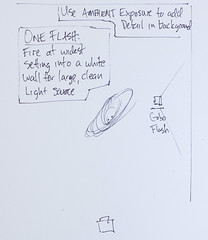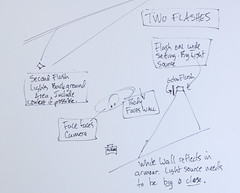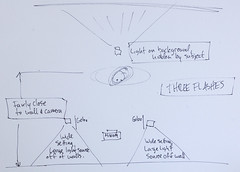 A few days ago a question popped up in the Strobist Flickr threads from reader Bruce Elliott, who was planning to photograph a man in a suit of armor. (The shot is to be used for publicity for a mountain climbing expedition for charity.)
A few days ago a question popped up in the Strobist Flickr threads from reader Bruce Elliott, who was planning to photograph a man in a suit of armor. (The shot is to be used for publicity for a mountain climbing expedition for charity.)The actual suit of armor is pictured here. Luckily, Bruce got a chance to see it (and snap a shot) early to help him plan. Being both specular and irregularly shaped, it presents a few challenges from a lighting standpoint. So let's step through some possible solutions a photographer might use based on how much access to gear they had. Like the candles post, this is a glimpse into the pre-thinking process that you should be employing whenever you have the opportunity.
 The first thing to consider in shooting a large, specular object is that you need a light source that is either close and big, or further away and huge. So let's start off with a wallet-friendly, no-flash approach.
The first thing to consider in shooting a large, specular object is that you need a light source that is either close and big, or further away and huge. So let's start off with a wallet-friendly, no-flash approach. The sky is an excellent light source candidate. But you'll need to find a location that gives you a fairly panoramic view of the sky to use it as both a light source and the background.
My first instinct would be to shoot the knightly climber from a low angle, to get a little bit of an "epic" connotation. This would give you a clean composition, and it gels well with the idea of using the sky as both light source and background. The trick is choosing both the appropriate time of day and shooting direction to make the sky better suit your needs.
So you'd want the panoramic spot as the location, and evening for the time of day for your shot. The late afternoon - and especially the westerly twilight - will make a good light source to illuminate the armor. It's huge, softly gradient, and dependable. Quick recycle time, too.
This leaves the easterly sky as your background. It'll have nice color and a lower tonal value, both of which will make it a good backdrop. Even a cloudy day could work with this setup. So weather would not be too much of a variable. Remember, the armor is going to see everything in its reflection. So a big, sweeping light source like the westerly sky just after sunset will add subtle layers of interest to the armor.
Adding one flash to this scenario, I would grid spot it and warm it up a little. This will give you total control of nearly every tone density in the photo. Remember, your sky is gonna be reflecting off of the armor, so it'll be a tad hot. You'll fix this by dropping the exposure a little, which might render the guy's face a little dark. A tight grid spot would pull it right back up. You could then continue to drop the exposure (by moving to higher shutter speeds) to make the environment just about as moody as you wanted, without losing the guy's face.
With a little trial-and-error, you should be able to place a small gobo in the correct spot between the gridded light and the subject to kill the small light's reflection in the armor.
 If you are strobing your knight, your light modifier is going to have to be something big. An umbrella will not work very well, as the convex shapes on the armor see a lot as far as reflections as concerned. I would go for a white wall (lit by a flash) to create a nice, big pool of light. I would back the flash up about 8 feet, and set the beam to the widest setting. Use the built-in ultrawide diffuser if it is so-equipped.
If you are strobing your knight, your light modifier is going to have to be something big. An umbrella will not work very well, as the convex shapes on the armor see a lot as far as reflections as concerned. I would go for a white wall (lit by a flash) to create a nice, big pool of light. I would back the flash up about 8 feet, and set the beam to the widest setting. Use the built-in ultrawide diffuser if it is so-equipped.Now the wall is your light source, which should give a clean, form-defining specular highlight in the armor. Shooting near a white-walled corner would allow you to control the density of the background by moving you and your subject closer or further from the back wall.
This technique is similar to the headshot-in-a-corner post in Lighting 101. But your light source is actually the reflecting wall, with no umbrella being used.
You would want to gobo the flash in two directions. First, between the flash and your lens, which will control your flare and allow you to back it away from the reflecting wall and place it close to the subject, just out of the frame. This will give you the largest apparent light source possible.
Also, you would want to place a small gobo in a position where it blocks the small, intense light source from creating a small hotspot on the armor.
 Moving to two small flashes and still using walls, we can sort of recreate the lighting design of the sky shot mentioned earlier. You'll be bouncing one flash of of a wall to create a nice, big light source. Then you would use the second to illuminate the background. The background could be another wall. Or it could be a painted backdrop or cheap piece of muslin. This would allow you to set up near a white wall just about anywhere.
Moving to two small flashes and still using walls, we can sort of recreate the lighting design of the sky shot mentioned earlier. You'll be bouncing one flash of of a wall to create a nice, big light source. Then you would use the second to illuminate the background. The background could be another wall. Or it could be a painted backdrop or cheap piece of muslin. This would allow you to set up near a white wall just about anywhere.You will still want to gobo the front (and probably back) flash in the spot that will keep it from leaving a small, hot specular on the armor. Remember, you are using the reflection of the splashed wall to define form. But it is important to kill the specular of the actual flash.
 Using three flashes, I would look for a white wall to be your light source, bouncing a flash off of the wall just behind the photog, on each side. The third flash could illuminate another wall, or a portable backdrop. Use the subject to hide the background flash. You would have easy control over the light levels of both the knight and the background this way.
Using three flashes, I would look for a white wall to be your light source, bouncing a flash off of the wall just behind the photog, on each side. The third flash could illuminate another wall, or a portable backdrop. Use the subject to hide the background flash. You would have easy control over the light levels of both the knight and the background this way.The common thread in the techniques are finding (or creating) large light sources to create nice, easily manageable highlights in the armor. A gridded flash can be used along with any of these setups to highlight the subject's face. Which, again, would give you total control over the relative values in the photos.
Of the three, I would probably go with the twilight sky-lit version with a warmed-up grid on his face. Maybe even balance to tungsten and stick a CTO gel on the grided face light and shoot on tungsten after twilight, for mood. Even better to add another 1/4 or 1/2 CTO on the face light to have warm against cool contrast.
If you have an lighting idea you are considering or an assignment that has you stumped, drop your questions and/or concerns into the Flickr discussion group threads. You'll find lots of people ready help with ideas and lighting techniques.




0 comments:
Post a Comment